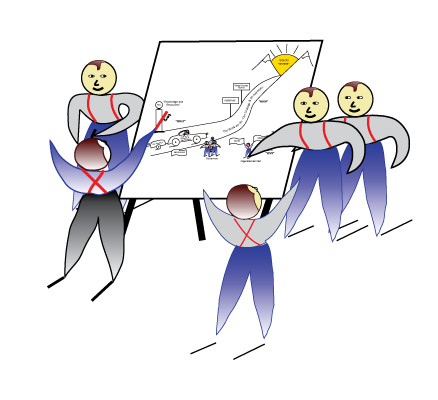July 2012 - The FoCuSeD™ Facilitator eNewsletter

Facilitation and Self-Organizing Teams – Focused Teams | Gary Rush Facilitation
In my February 2012 The FoCuSeD™ Facilitator eNewsletter, I wrote about Facilitation Skills and Teams – Focused Teams and said that I’d explore this topic further. (Focused Teams are relatively new and a growing trend in many industries.) Here, I will explore how facilitation skills enable Focused Teams to work effectively.
Focused Teams
In my eNewsletter, I defined a Focused Team as: a group of people from multiple professions and/or disciplines, without an obvious “leader”, who form, temporarily, for a specific purpose. A Focused Team forms quickly and remains as a team for a short time. Because of this, facilitation skills are critical. This type of team forms in (amongst many others):
- Healthcare – doctors, nurses, technicians, etc., collaboratively treat patients.
- Product Design – multiple disciplines collaborate for ideation of new products.
- Consulting – short-term teams respond to client needs, requests for proposal, and client issues.
- Corporations – temporary teams deal with an incident, a problem, a crisis, etc.
- Emergencies – ad hoc emergency response teams handle the emergency.
Enabling Focused Teams to work effectively requires practices that are different from a standard workshop process – i.e., there is no time for preparation; there are no Facilitator notes (Annotated Agenda); there is no formal process to follow; and each team member documents results as needed.
Enabling Focused Teams to work effectively
Establishing, at the beginning of the Focused Team forming, how the team will work is essential to ensure that they are consistent in their work so that nothing is missed and effective decisions are made. Focused Teams require clear roles and responsibilities, a purpose for existing, agreed to guiding principles, defined process steps to enable them to work effectively, and an after action review for continuous improvement. This should take no more than a couple of minutes.
Assign Roles. Clarify roles and responsibilities so that everyone knows his or her role. Deciding who will facilitate is critical. The others automatically become Team Members. The Client is generally not involved other than receiving the benefit of the team’s actions. Roles and responsibilities are:
- Facilitator – this role facilitates the discussion, manages conflict, and facilitates differences that may arise between team members. In addition, this role ensures that each Team Member captures results, as needed.
- Team Member – this role participates in the discussion contributing his or her knowledge and ideas.
- Client – this role defines the reason for the existence of the team (the patient, product client, consulting client, etc.).
Define the Purpose. Agree on a simple statement (doesn’t have to be written down) that defines why the Focused Team formed. Example – “We will determine the next course of treatment for patient X”. This provides a common goal, which helps a team form.
Agree on Guiding Principles. These ensure that the Focused Team exhibits a collaborative set of behaviors. These define how they will conduct themselves while working together. Each Focused Team can set their own Guiding Principles, but since they often form quickly, here is a beginning set of Guiding Principles to keep in mind:
- All Team Members are equal – while in the Focused Team, each Team Member is equal in discussion and decision-making.
- Respect all ideas – all ideas are needed and even though not all are best for the situation, all ideas need to surface so that the Focused Team can find the one that works for them. Stifling ideas reduces the opportunity to find a creative solution or answer.
- Stay in Role – the roles need to be respected and no one Team Member should “pull rank” on another. It is a collaborative effort.
Define the Process Steps to follow. This is essential to ensure that the Focused Team knows how they will accomplish their task. The most efficient and effective way to define the process is to ask:
- What is the single question that we need to answer? Typically, we take the purpose of the Focused Team and rewrite it as a question. Example – “What is the next course of treatment for patient X”?
- What are the sub-questions? List out all of the questions that need answers to enable the Focused Team to answer the single question, above.
- What is the sequence? Sequence the sub-questions in the order they need to be answered (there may not always be a sequence).
- How might we group the sub-questions? Some sub-questions might be grouped together as one activity. Example – “What is the patient’s blood pressure”? and “What is the patient’s temperature”?, may all fall under, “What are the patient’s vitals”?
Following these steps will enable the Focused Team to accomplish their common goal without missing critical steps.
After Action Review
Capturing lessons learned to help improve performance is handled by a short review after the Focused Team has completed its task. Each Focused Team should take 5 minutes to quickly capture:
- What worked?
- What needs to improve?
- How do we incorporate the lessons learned next time?
By doing this, a Focused Team will continuously improve their performance with each instance they form. These lessons learned should also be shared with other Focused Teams within their organization.
Summary
The New Set of Skills and the Common Competencies defined in the February 2012 eNewsletter, along with the defined Roles and Responsibilities, Defined Purpose, Guiding Principles, Defined Process Steps, and After Action Review described here, will enable Focused Teams to be consistent in their work and to make effective decisions. Virtually everyone needs facilitation skills. Working collaboratively, following these guidelines, increases the effectiveness of the Focused Team, increases the quality of their work, and improves the relationships between the team members. ![]()

